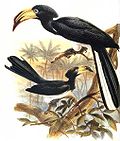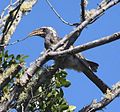| Image | Scientific name | Common name | Distribution |
|---|
 | Lophoceros alboterminatus | Crowned hornbill | northeastern Africa |
 | Lophoceros bradfieldi | Bradfield's hornbill | northern Botswana, southern Angola and eastern Zimbabwe |
 | Lophoceros fasciatus | Congo pied hornbill | Nigeria to northern Angola and Uganda |
 | Lophoceros semifasciatus | West African pied hornbill | Senegal and Gambia to southern Nigeria |
 | Lophoceros hemprichii | Hemprich's hornbill | Djibouti, Eritrea, Ethiopia, Kenya, Somalia, South Sudan, and Uganda |
 | Lophoceros pallidirostris | Pale-billed hornbill | Angola, DRC, Kenya, Malawi, Mozambique, Tanzania, and Zambia. |
 | Lophoceros nasutus | African grey hornbill | Sub-Saharan Africa and into Arabia |
 | Lophoceros camurus | Red-billed dwarf hornbill | Angola, Benin, Cameroon, Central African Republic, Republic of the Congo, Democratic Republic of the Congo, Ivory Coast, Equatorial Guinea, Gabon, Ghana, Guinea, Liberia, Nigeria, Sierra Leone, South Sudan, and Uganda. |
|
















